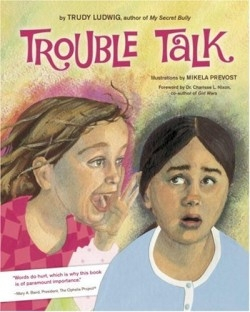Trouble Talk
“I know a girl who has a really big mouth. Her name is Bailey. Big Mouth Bailey.” In this picture book about the consequences of gossip and hurtful language, shy Maya has never called her that out loud, but that’s what she thinks of the new girl in class. Although Maya is nervous about being Bailey’s “Welcome Buddy,” she is soon thrilled to be part of her constant chatter at lunch and after school. The young girl begins to question Bailey’s intentions, however, when her remarks toward other friends turn cruel and embarrassing.
Maya becomes Bailey’s next victim after Bailey overhears Maya’s parents arguing and spreads rumors that her parents are ready to divorce. The gossip not only affects Maya emotionally but physically as well, as she can no longer concentrate in class and develops a stomachache. When her teacher recommends that she talk to Ms. Bloom, the school counselor, Maya learns that Bailey “has a bad case of trouble talk.” She also learns how she can avoid joining in and feeling caught in the middle of friends. After noticing Bailey’s remorsefulness and change in actions later, Maya remains hopeful that she can resume their friendship.
A national speaker on bullying and children’s social interactions, author Trudy Ludwig is a member of the International Bullying Prevention Association, collaborates with leading anti-bullying organizations, and has appeared on ABC’s Good Morning America and on PBS’s Keeping Kids Healthy. Her previous books include My Secret Bully, Just Kidding, and Sorry! First-time illustrator Mikela Prevost’s watercolor, gouache, acrylic, and vibrant, patterned cut-paper artwork highlights the intensity of Maya’s problems. At the forefront of the eye-catching illustrations are the character’s expressive faces, revealing their delight, shock, anger, embarrassment, and concern.
While the message in Trouble Talk is clear to young children, the story is realistic and does not become didactic. A foreword by Charisse L. Nixon, director of research for the Ophelia Project, explains that girls are more vulnerable to this destructive way of connecting to their peers. The author concludes with a brief note on relational aggression, ways to engage children in healthier friendships and empower bystanders of trouble talk, questions for discussion, a list of related organizations and Web sites, and a bibliography. As she notes that researchers are discovering that trouble talk is on the rise and equally or even more harmful than physical bullying, this picture book will prove to be a valuable resource for children, educators, and parents alike.
Disclosure: This article is not an endorsement, but a review. The publisher of this book provided free copies of the book to have their book reviewed by a professional reviewer. No fee was paid by the publisher for this review. Foreword Reviews only recommends books that we love. Foreword Magazine, Inc. is disclosing this in accordance with the Federal Trade Commission’s 16 CFR, Part 255.

